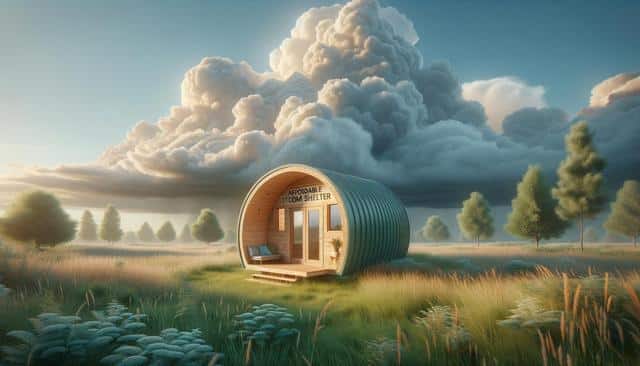
Affordable & Durable Storm Shelters: Storm shelters provide protection during severe weather, ensuring safety
Understanding the Value of Affordable Storm Shelters
Storm shelters are essential safety structures designed to protect individuals and families during severe weather events such as tornadoes and hurricanes. Fortunately, affordability doesn’t have to compromise safety. Modern design innovations and materials have made it possible for homeowners to access cost-effective options without sacrificing structural integrity. Whether you live in a region prone to seasonal storms or unexpected weather events, having a storm shelter in place can offer peace of mind and life-saving protection.
Affordable storm shelters come in various forms to meet individual needs and budgets. Precast concrete shelter options are widely available and offer excellent resistance to high winds and flying debris. These shelters are often installed underground or in garages to maximize protection. For those looking for a more discreet solution, a hidden storm shelter in your state can provide safety without taking up visible space in your home or yard. Additionally, inground storm shelters offer a secure refuge and are commonly built to comply with FEMA guidelines for impact resistance and wind pressure.
Types of Storm Shelters to Consider
When choosing a storm shelter, understanding the different types available can help you make an informed decision. Each type comes with its own benefits depending on space availability, budget, and local weather risks. Here are the most common storm shelter types:
- Inground Storm Shelters: Installed beneath the surface, these shelters are often made from concrete or steel and provide excellent protection from extreme weather conditions.
- Above Ground Storm Shelters: These are ideal for homes without basements or for individuals with mobility limitations. They are anchored to a concrete slab and built to resist high-impact forces.
- Garage or In-Home Safe Rooms: Designed for easy access, these are often built into existing structures and are a practical solution for quick sheltering.
Inground storm shelters in your state may be especially beneficial in areas where soil conditions and local building codes support underground installation. Above ground storm shelters, on the other hand, are often easier to install and may be more suitable for urban homes or those with limited yard space.
Durable Materials That Don’t Break the Bank
The materials used in storm shelter construction greatly influence both the cost and durability of the unit. Fortunately, several affordable materials offer high performance in severe weather conditions. Precast concrete shelters are among the most durable and cost-efficient solutions. These shelters are manufactured off-site and delivered ready to install, reducing labor costs and construction time.
For those seeking a more lightweight alternative, fiberglass shelters are a popular choice. While not as heavy-duty as concrete, fiberglass units are resistant to corrosion and can be installed both above and below ground. Steel shelters are another solid option, offering a blend of strength and longevity. These units often come pre-fabricated and can be customized based on space and accessibility requirements.
When evaluating options, consider the following features for long-term value:
- Corrosion resistance for underground installations
- Wind and impact ratings meeting FEMA or ICC guidelines
- Locking mechanisms and ventilation systems for safety and comfort
A hidden storm shelter in your state may incorporate some of these materials while remaining out of sight, making it a practical solution for homeowners who prefer discreet safety measures without compromising structural integrity.
Installation Options and Considerations
One of the key advantages of affordable storm shelters today is the availability of prefabricated units. These ready-made solutions simplify the installation process, often requiring only a few hours to set up. Depending on your chosen type—whether inground, above ground, or hidden—you’ll want to coordinate with a certified installer to ensure proper anchoring and compliance with local building codes.
Inground storm shelters {state} may require excavation and site preparation, but they offer excellent protection and can be placed in various locations such as backyards or even beneath garage floors. Above ground storm shelters are typically easier and quicker to install. These units can be bolted to an existing concrete slab and require minimal alterations to your property.
When planning for installation, keep the following factors in mind:
- Proximity to your home’s main living areas for quick access
- Soil composition and drainage to prevent water intrusion
- Local permit requirements and inspection protocols
Taking the time to match the installation method with your shelter type will ensure long-term performance and peace of mind, especially during storm season.
Choosing the Right Shelter for Your Needs
Choosing the right storm shelter involves balancing budget, space, and safety requirements. Fortunately, there are many affordable solutions that cater to a wide range of preferences. For example, a precast concrete shelter {state} offers both strength and affordability, making it a popular choice among homeowners. Likewise, a hidden storm shelter {state} is ideal for those who value discreet design and convenience.
Personal needs also play a major role in the decision-making process. For families with elderly members or individuals with limited mobility, above ground storm shelters provide quick and safe access. In contrast, inground storm shelters offer added protection from debris and wind, making them suitable for high-risk areas.
To ensure you make the right choice, consider these practical tips:
- Assess your region’s storm frequency and severity
- Evaluate available space in and around your home
- Consult with local shelter providers familiar with inground storm shelters {state}
- Request professional assessments and quotes for different models
No matter which type you choose, prioritizing materials, design, and certified construction standards will help you invest in a shelter that is affordable, durable, and reliable when you need it most.
Conclusion: Protecting What Matters Most
Investing in an affordable storm shelter is a practical and potentially life-saving decision for many homeowners. With a variety of options available—from precast concrete shelters to hidden and above ground designs—there’s a solution to fit almost any budget or space constraint. Whether you’re considering inground storm shelters or prefabricated above ground options, the key is to choose a model that meets both your safety needs and local environmental conditions.
By focusing on durability, installation efficiency, and compliance with safety standards, you can find a shelter that not only protects your household but also adds value to your property. Explore the available storm shelter options in your state and take the next step toward securing peace of mind during severe weather.


